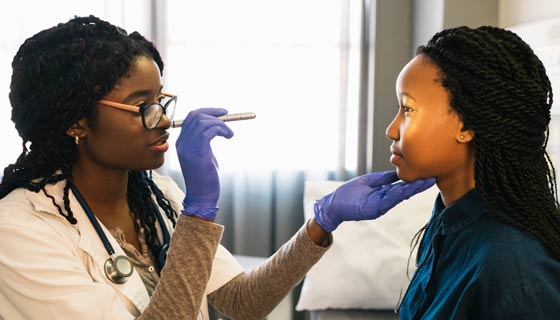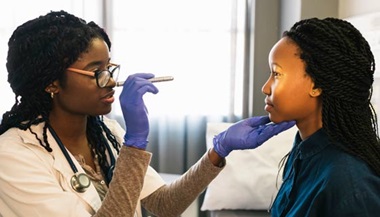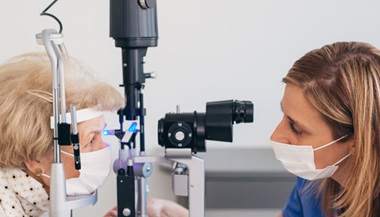Retinitis Pigmentosa
Featured Expert
What is retinitis pigmentosa?
Retinitis pigmentosa is the name of a group of eye diseases that are caused by genetic variants. It involves the eye’s retina, the nerve layer that lines the back of the eye and is sensitive to light. Initially, retinitis pigmentosa causes poor vision in dim light, and in most cases, progresses to a constriction in the visual field that causes tunnel vision and a decline in eyesight even in good lighting. Mandeep Singh, M.B.B.S., M.D., Ph.D., explains the condition and its symptoms, diagnosis and treatment options.
What You Need to Know
- Retinitis pigmentosa is a group of eye disorders that are inherited and involve the eye’s retina.
- Retinitis pigmentosa causes a slow decline in eyesight and the field of vision.
- Symptoms usually begin in childhood or adolescence.
- Genetic testing by a certified genetic counselor is recommended.
- Avoid taking greater than 30 international units (IU)/day of vitamin E supplements.
- Vitamin A supplementation is not beneficial in terms of reducing disease progression, based on the latest research.
- Use sunglasses for protection against bright sunlight.
What causes retinitis pigmentosa?
Retinitis pigmentosa is caused by variants (or mutations) in genes, says Singh. Each patient could harbor a variant in one or more of almost 100 genes. All of these variants ultimately disturb the function of retinal cells and affect the ability of the retina to sense light. Some of the gene variants tend to affect other family members, such as siblings, parents, cousins, aunts or uncles — but many tend to affect just one person in the entire family.
Genetic testing can be done to determine the exact sequence of the underlying genetic variant. By learning which gene is causing their retinitis pigmentosa, or their family member’s, people can understand whether or not they are a candidate for ongoing clinical trials. Some patients also want to know if their gene variant has a high risk of being passed down to future generations. Certain genes require affected people to be aware of nutritional precautions and recommendations in order to prevent rapid disease progress.
What are the symptoms of retinitis pigmentosa?
Retinitis pigmentosa symptoms usually begin in childhood or adolescence. However, each person may experience symptoms differently. Some people with the problem have a slow, very progressive loss of eyesight. Others lose their eyesight much more quickly and severely. Common symptoms may include:
- Reduced vision in poor lighting or dark conditions, or in shadows
- Reduced ability to see objects in the peripheral vision
- Gradual narrowing of the total area of good vision
- Stumbling or tripping over objects in the periphery
- In advanced cases, central vision can be affected with blurriness and missing vision
The symptoms of this condition may look like other eye diseases. Talk with your eye doctor for a diagnosis.
How is retinitis pigmentosa diagnosed?
An eye-care professional will take a complete medical history and give you an eye exam. The eye doctor may perform one or more of the following tests to make a diagnosis:
- Eye chart test
- Ophthalmoscopy
- Refraction test
- Retinal exam
- Electroretinography
- Visual field measurement
- Genetic testing by a certified genetic counselor
How is retinitis pigmentosa treated?
There is a Food and Drug Administration-approved gene therapy for only one gene (among almost 100) that causes retinitis pigmentosa — the RPE65 gene. The treatment is called voretigene neparvovec (Luxturna). Cases of RPE65 gene-related retinitis pigmentosa are very rare. Genetic testing by a certified genetic counselor can help you find out if you are carrying variants in this gene and could be a candidate for gene therapy.
At this time, there are no FDA-approved treatments for the other genetic variants that cause retinitis pigmentosa. However, numerous clinical trials are ongoing, some of which address specific genes. Genetic testing by a certified genetic counselor can help you find out whether you could match with an ongoing clinical trial, and you can decide if you wish to volunteer to participate.
People with retinitis pigmentosa can experience other eye conditions that could degrade their vision, such as cataracts and macular edema, or retinal swelling. Cataracts can be treated with surgery. Macular edema can sometimes be treated with medication. People who have been diagnosed with retinitis pigmentosa should see their eye doctor regularly to monitor for these treatable conditions.
High levels of vitamin E may worsen retinitis pigmentosa, so people with the condition should avoid taking vitamin E supplementation in excess of 30 IU per day. Vitamin E supplements are typically marketed as strong antioxidants.
New research has shown that high doses of vitamin A are not beneficial, as was previously thought.
It is important to protect the retinas from bright sunlight — sunglasses with a UV filter are considered generally protective.
Talk with your eye care clinician for more information about the benefits of regular follow-up visits.
“At the Genetic Eye Disease Center at Johns Hopkins, we monitor our patients with retinitis pigmentosa regularly to keep their eyes as healthy as possible,” says Singh. “It is so important to discuss the ongoing clinical trials and whether they may be eligible to participate.”
What are the complications of retinitis pigmentosa?
Retinitis pigmentosa causes a progressive loss of eyesight. It may happen slowly or more quickly, but generally progresses over years. People with retinitis pigmentosa can also develop early onset cataracts and retinal swelling (technically known as macular edema).
Living With Retinitis Pigmentosa
Retinitis pigmentosa is a progressive condition, which means it will get worse over time. Talk with your eye doctor to get information on services and devices for people with low vision.
When should I call my eye doctor?
If your symptoms get worse or you have new symptoms, call your eye doctor.
Treatment Tips to Help You Get the Most From a Visit to Your Eye-Care Professional
- Know the reason for your visit and what you want to happen.
- Before your visit, write down questions you want answered.
- Bring someone with you to help you ask questions and remember what the clinician tells you.
- At the visit, write down the name of a new diagnosis, and any new medicines, treatments or tests. Also write down any new instructions your doctor gives you.
- Know why a new medicine or treatment is prescribed, and how it will help you. Also know what the side effects are.
- Ask if your condition can be treated in other ways.
- Know why a test or procedure is recommended and what the results could mean.
- Know what to expect if you do not take the medicine or have the test or procedure.
- If you have a follow-up appointment, write down the date, time and purpose for that visit.
- Know how you can contact your eye doctor if you have questions.







